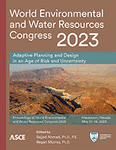Effect of Modeling Setup Parameters in SWMM Predictions of Large-Scale Tunnel Filling
Publication: World Environmental and Water Resources Congress 2023
ABSTRACT
Due to its robustness, versatility, and open-source, EPA’s Storm Water Management Model (SWMM) has become one of the most popular applications used for urban hydraulics analysis nowadays. One reason that explains the model popularity is the ability to predict flow in complex stormwater systems with reasonable accuracy in realistic inflow conditions. However, in highly dynamic conditions associated with extreme inflows, recent research indicated that SWMM accuracy can be improved with spatial accuracy and smaller time steps. Yet, even among approaches to representing stormwater systems using spatial discretization, there are alternative approaches regarding pressurization algorithms that are not fully understood. The aim of this work is to evaluate how modeled results of piezometric head and flow hydrograph in a stormwater tunnel are affected by varying discretization and pressurization algorithms in SWMM. Comparisons with a combination of three different spatial discretization (link-node and two different spatial discretizations), three different algorithms to solve pressurized flow (EXTRAN, original SLOT, and a custom SLOT with pressure wave celerity of 250 m/s), and 10 different time step discretizations with Hydraulic Analysis for Sewer and Tunnels (HAST), a model specifically designed to simulate surges in tunnels, are presented. These alternative solutions are placed on a real-world stormwater tunnel subjected to a rain event. SWMM’s outputs are evaluated using flow continuity errors and Nash-Sutcliffe normalized statistic. Results show that in relation to the Richmond Tunnel, the DxD 10 spatial discretization proved to be the most reliable, especially when combined with the SWMM standard Preissmann slot algorithm and a time step factor ranging from 0.01 to 1 from the time step calculated using Courant number. The EXTRAN algorithm only showed good results when combined with DxD 10 spatial discretization and time step factor of 1. The DxD 05 discretization presented acceptable results when used with SWMM standard Preissmann slot algorithm and time step factor of 0.01 and 0.02. Link-node setups did not show satisfactory results. Furthermore, this study demonstrates that ensuring small flow continuity errors is not enough to achieve representative flow rates using SWMM, highlighting that another parameter should be taken into account to evaluate numerical oscillation.
Get full access to this article
View all available purchase options and get full access to this chapter.
REFERENCES
Dorward, M., D. Wood, R. Edison, S. Lowry, and D. Donahue. 2013. Richmond Transport/Storage Box (Tunnel) Numerical Modeling Technical Memorandum.
EPA. 2020. Storm Water Management Model (SWMM). Cincinnatti, Ohio.
Li, J., and A. McCorquodale. 1999. “Modeling Mixed Flow in Storm Sewers.” J. Hydraul. Eng., 125 (1983): 1170–1180. https://doi.org/10.1061/(ASCE)0733-9429(1999)125:11(1170).
Nash, J. E., and J. V. Sutcliffe. 1970. “River flow forecasting through conceptual models part I - A discussion of principles.” J. Hydrol., 10 (3): 282–290. https://doi.org/10.1016/0022-1694(70)90255-6.
Pachaly, R. L., J. G. Vasconcelos, and D. G. Allasia. 2021. “Surge predictions in a large stormwater tunnel system using SWMM.” Urban Water J., 18 (8): 577–584. https://doi.org/10.1080/1573062X.2021.1916828.
Pachaly, R., J. Vasconcelos, D. Allasia, and B. Minetto. 2019. “Field evaluation of discretized model setups for the storm water management model.” J. Water Manag. Model., 2019: 1–10. https://doi.org/10.14796/JWMM.C463.
Preissmann, A. 1961. “Propagation of translatory waves in channels and rivers.” Proc., 1st Congr. French Assoc. Comput., 432–443.
Ridgway, K. 2010. “Evaluating Force Main Transients with SWMM5 and Other Programs.” J. Water Manag. Model., 6062: 43–54. https://doi.org/10.14796/jwmm.r236-04.
Roesner, L. A., J. A. Aldrich, and R. E. Dickinson. 1988. Storm Water Management Model User’s Manual Version 4: Extran Addendum.
Rossman, L. A. 2006. Storm Water Management Model Quality Assurance Report: Dynamic Wave Flow Routing. (September): 115.
Sturm, T. 2001. Open Channel Hydraulics. McGraw-Hill Science/Engineering/Math.
Vasconcelos, J. G., Y. Eldayih, Y. Zhao, and J. A. Jamily. 2018. “Evaluating storm water management model accuracy in conditions of mixed flows.” J. Water Manag. Model., 2018: 1–10. https://doi.org/10.14796/JWMM.C451.
Vasconcelos, J. G., and S. J. Wright. 2007. “Comparison between the two-component pressure approach and current transient flow solvers.” J. Hydraul. Res., 45 (2): 178–187. https://doi.org/10.1080/00221686.2007.9521758.
Vasconcelos, J. G., S. J. Wright, and P. L. Roe. 2006. “Improved Simulation of Flow Regime Transition in Sewers: Two-Component Pressure Approach.” J. Hydraul. Eng., 132 (June): 553–562. https://doi.org/10.1061/(ASCE)0733-9429(2006)132:6(553).
Information & Authors
Information
Published In
History
Published online: May 18, 2023
ASCE Technical Topics:
- Algorithms
- Engineering fundamentals
- Environmental engineering
- Geotechnical engineering
- Hydraulic models
- Hydrologic engineering
- Hydrology
- Inflow
- Mathematics
- Model accuracy
- Models (by type)
- Parameters (statistics)
- River engineering
- Rivers and streams
- Runoff
- Statistics
- Stormwater management
- Tunnels
- Water and water resources
- Water treatment
Authors
Metrics & Citations
Metrics
Citations
Download citation
If you have the appropriate software installed, you can download article citation data to the citation manager of your choice. Simply select your manager software from the list below and click Download.
